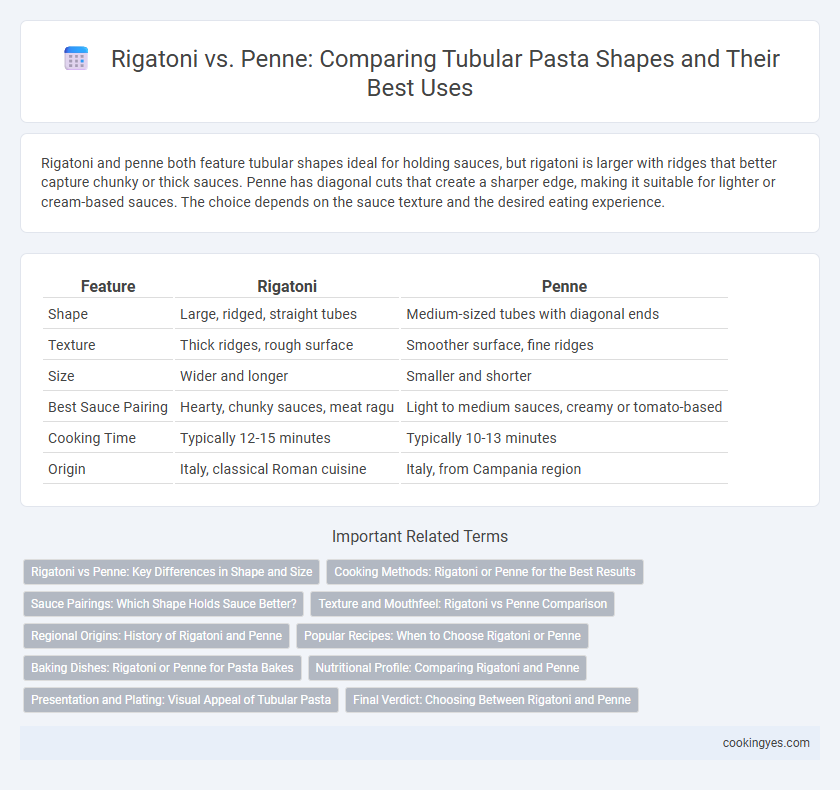Rigatoni and penne both feature tubular shapes ideal for holding sauces, but rigatoni is larger with ridges that better capture chunky or thick sauces. Penne has diagonal cuts that create a sharper edge, making it suitable for lighter or cream-based sauces. The choice depends on the sauce texture and the desired eating experience.
Table of Comparison
| Feature | Rigatoni | Penne |
|---|---|---|
| Shape | Large, ridged, straight tubes | Medium-sized tubes with diagonal ends |
| Texture | Thick ridges, rough surface | Smoother surface, fine ridges |
| Size | Wider and longer | Smaller and shorter |
| Best Sauce Pairing | Hearty, chunky sauces, meat ragu | Light to medium sauces, creamy or tomato-based |
| Cooking Time | Typically 12-15 minutes | Typically 10-13 minutes |
| Origin | Italy, classical Roman cuisine | Italy, from Campania region |
Rigatoni vs Penne: Key Differences in Shape and Size
Rigatoni features larger, ridged tubes with straight-cut ends, making it ideal for thick sauces that cling to its textured surface. Penne has smaller, smooth tubes with angled, diagonal cuts that create a more elegant presentation and help capture lighter sauces inside. The size and shape differences affect cooking times and sauce retention, influencing the choice depending on the dish's texture and flavor intensity.
Cooking Methods: Rigatoni or Penne for the Best Results
Rigatoni's wider diameter and ridged surface enable it to hold thicker sauces and bake well in casseroles, making it ideal for slow-cooked, hearty dishes. Penne's smaller size and diagonal cut promote even cooking and work best in quick sautes and lighter cream or tomato-based sauces. Choosing Rigatoni or Penne depends on sauce thickness and cooking time, as Rigatoni excels with robust textures while Penne suits more delicate preparations.
Sauce Pairings: Which Shape Holds Sauce Better?
Rigatoni's ridged surface and larger diameter provide superior sauce retention, making it ideal for thick, chunky sauces like Bolognese and sausage ragu. Penne, with its smooth or ridged exterior and smaller tube, complements lighter, cream-based sauces such as Alfredo or vodka sauce by allowing a balanced sauce coating. For robust, hearty sauces, rigatoni ensures maximum flavor capture, while penne's shape excels in evenly distributing delicate sauces.
Texture and Mouthfeel: Rigatoni vs Penne Comparison
Rigatoni features ridges and a larger diameter, providing a chewy texture and a robust mouthfeel that holds thicker sauces well. Penne has a smoother surface and smaller tube size, offering a tender bite with a lighter texture ideal for lighter, creamy sauces. The structural differences in rigatoni versus penne create distinct eating experiences, influencing sauce retention and overall dish consistency.
Regional Origins: History of Rigatoni and Penne
Rigatoni originated in central and southern Italy, particularly Lazio and Campania, where its ridged, large tubular shape was designed to hold hearty sauces typical of the region. Penne, developed in the Liguria region of northern Italy in the 19th century, features smooth or ridged diagonal cuts that facilitate even sauce absorption. Both pasta types reflect their regional culinary traditions, highlighting the diversity of Italian pasta-making history.
Popular Recipes: When to Choose Rigatoni or Penne
Rigatoni's larger, ridged tubes hold chunky sauces like Bolognese or sausage ragu, making it ideal for hearty dishes that benefit from its texture and size. Penne's smaller, smoother or ridged tubes work well with lighter sauces such as arrabbiata or pesto, allowing for even coating and easy bite-sized servings. Choosing rigatoni enhances robust, slow-cooked meals while penne excels in quick, versatile recipes with thinner sauces.
Baking Dishes: Rigatoni or Penne for Pasta Bakes
Rigatoni's ridged surface and larger diameter make it ideal for pasta bakes, as it holds sauces and cheese more effectively than penne. Penne's smooth surface and smaller size allow for quicker cooking but may result in less sauce retention in baked dishes. Choosing rigatoni enhances the texture and flavor distribution in baked pasta recipes, making it a preferred option for casseroles and oven-baked meals.
Nutritional Profile: Comparing Rigatoni and Penne
Rigatoni and penne, both tubular pasta shapes, share similar nutritional profiles with minor differences in calorie and carbohydrate content depending on the brand and flour used. Typically, whole wheat variants of rigatoni and penne offer higher fiber and protein levels compared to their refined counterparts. Choosing between rigatoni and penne, the nutritional impact is minimal, making texture and sauce pairing more critical factors than nutrient variations.
Presentation and Plating: Visual Appeal of Tubular Pasta
Rigatoni and penne both offer distinct visual appeal in plating, with rigatoni's larger, ridged tubes providing a robust, textured surface that catches sauces and creates bold, eye-catching presentations. Penne's smaller, smooth-cut tubes with angled ends add a refined, elegant look, emphasizing precision and a sleek silhouette on the plate. Choosing between rigatoni and penne depends on the desired presentation style--rigatoni enhances rustic, hearty dishes, while penne suits more delicate, contemporary plating.
Final Verdict: Choosing Between Rigatoni and Penne
Rigatoni features larger, ridged tubes that hold chunky sauces well, making it ideal for hearty dishes, while penne's smaller, diagonal-cut tubes offer versatility and a smoother sauce coating. For robust, textured sauces or baked pasta recipes, rigatoni provides superior sauce retention and a satisfying bite. Penne excels in lighter pasta salads or creamy sauces where ease of eating and subtle sauce absorption are preferred.
Rigatoni vs penne for tubular shapes Infographic

 cookingyes.com
cookingyes.com